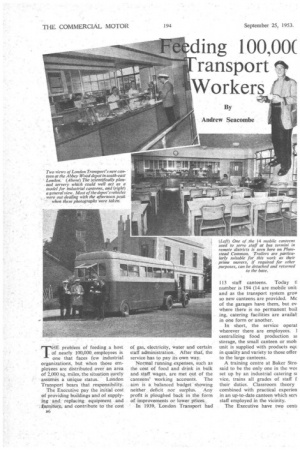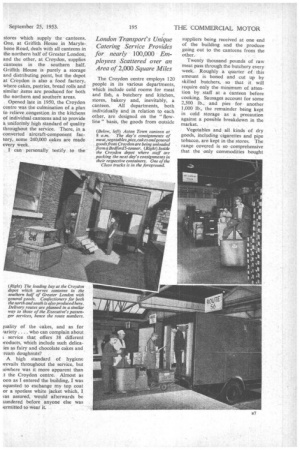ding 100,00( ransport e4 Workers
Page 40

Page 41

Page 42

If you've noticed an error in this article please click here to report it so we can fix it.
By Andrew Seacombe
THE , HE problem of feeding a host a nearly 100,000 employees is one that faces few industrial organizations, _but when those emploYees are distributed over, an area of 2,000 sq. miles, the situation surely assfirnes a unique status. London Transport bears that responsibility.
The Executive pay the initial cost of providing buildings and of supplyingand replacing equipment and furniture, and contribute to the cost a6 of gas, electricity, water and certain staff administration. After that the service has to pay its own way.
Normal running expenses, such as the cost of food and drink in bulk and staff wages, are met out of the canteens' working accounts. The aim is a balanced budget showing neither deficit nor surplus. Any profit is ploughed back in the form of improvements or lower prices.
In 1939, London Transport had 113 staff canteens. Today ti number is 194 (14 are mobile unit and as the transport system grov so new canteens are provided. Mc of the garages have them, but ev, where there is no permanent buil ing, catering facilities are availat in one form or another.
In short, the service operal wherever there are employees. centralizing food production ai storage, the small canteen or mob unit is supplied with products ecp.: in quality and variety to those offer to the large canteens.
A training centre at Baker Strel said to be the only one in the woi set up by an industrial catering n vice, trains all grades of staff f their duties. Classroom theory combined with practical experien in an up-to-date canteen which sen staff employed in the vicinity.
The Executive have.two centi stores which supply the canteens. One, at Griffith House in Maryle-, bone Road, deals with all canteens in the northern half of Greater London, and the other, at Croydon, supplies canteens in the southern half. Griffith House is purely a storage and distributing point, but the depot at Croydon is also a food factory, where cakes, pastries, bread rolls and similar items are produced for both the northern and southern areas.
Opened late in 1950, the Croydon centre was the culmination of a plan to relieve congestion in the kitchens of individual canteens and to provide a uniformly high standard of quality throughout the service. There, in a converted aircraft-component factory, some 240,000 cakes are made every Week.
I can personally testify to the tuality of the cakes, and as for 7ariety. . .. who can complain about L service that offers 38 different Products, which include such delicaies as fairy and chocolate cakes and Team doughnuts?
A high standard of hygiene Prevails throughout the service, but Lowhere was it more apparent than the Croydon centre. Almost as oon as I entered the building, I was equested to exchange my top coat or a spotless white jacket which, I vas assured, would afterwards be lundered before anyone else was Permitted to wear it. The Croydon centre employs 120 people in its various departments, which include cold rooms for meat and fish, a butchery and kitchen, stores, bakery and, inevitably, a canteen. All departments, both individually and in relation to each other, are designed on the " flowline " basis, the goods from outside suppliers being received at one end of the building and the produce going out to the canteens from the other.
Twenty thousand pounds of raw meat pass through the butchery every week. Roughly a quarter of this amount is boned and cut up by skilled butchers, so that it will require only the minimum of attention by staff at a canteen before cooking. Sausages account for some 2,500 lb., and pies for another 1,000 lb., the remainder being kept in cold storage as a precaution against a possible breakdown in the market.
Vegetables and all kinds of dry goods, including cigarettes and pipe tobacco, are kept in the stores. The range covered is so comprehensive that the only commodities bought by canteens locally are bread and milk. Canteens give the centres four days' notice of their requirements and have 216 items from which to select. Deliveries from Croydon begin at 7 a.m. All consignments are made up ready for loading into the delivery vehicles during the afternoon of the previous day. There must be the minimum of delay in loading the following morning. Half-an-hour is allowed, but I was told that the vehicles are invariably away by 7.20 a.m.
Standard packages are used. Fibre containers resembling ordinary travelling cases are used for vegetables and dry goods, and aluminium containers for meat, sausages and fish. Sealed containers are employed for cigarettes and tobacco. Confectionery trays are of a standard size, so that they are interchangeable in the vans specia117 designed to carry them. Each vehicle can take 15(1.
Mechanical Handling Mechanical handling is employed wherever possible. Two Clem electric fork-lift trucks are used in conjunction with stillages to transfer the containers from the stores to the loading bay. The 48.-volt power units of these vehicles are charged each night in the factory's own maintenance department. , Of a total fleet of 19 delivery vehicles used by the canteen service, 10 are based on Croydon. Eight are Bedford •5-toriners and two are Austin -5-tonners. Bodywork is metal-panelled on wooden framework, roller shutters being incorporated in each. Thirteen of the fleet are equipped with light-alloy racks to carry confectionery trays. Each vehicle is operated by a driver and mate, who are responsible for loading and unloading.
-Nine Rounds There are nine delivery rounds from Croydon. Each is planned in a similar way to a bus route, and is allocated a route number. Route 52, for example, covers canteens at Chiswick, Turnham Green, Acton Town, Northfields, Isleworth, Hounslow, Fulwell, Twickenham, Mortlake, Ealing Common, Putney Bridge and Cherverton Road.
Routes are planned, as much as possible, according to the time at which canteens require their deliveries, but economy in mileage is always an important consideration.
Canteens vary in size and construction, but they all operate on the same basis. Dorking, with accommodation for 16, is one of the small est, and Camberwell, which seats 192, one of the largest. (This article is concerned only with garage canteens, and works canteens, such as the one at Chiswick seating about 1,000, are excluded.) The position of canteens, too, differs according to circumstances. Some are built at ground level, and others higher. An official" of the service had some interesting advice to offer on this point. "Build canteens on the ground floor to attract customers. If there are stairs to climb, platform staff who have been up and down stairs all day tend to walk to the cafe across the street," he said Canteen facilities are not planned in relation to any particular bus schedule. Where demand warrants it, a canteen will remain open throughout the night, but generally they open at 6.30 a.m. arid close at 10 p,tri. Breakfast is available from 6.30 a.m. until 11 a.m., luncheon from noon until 2.30 p.m.„ and dinner from about 5 p.m. until 10 p.m. During the intervening period, and at all times, -light meals can be bought. Cooked meals are available all night at the canteens remaining open.
Courses of a cooked meal are sold separately. Soup costs 3d., roast beef lid., two vegetables 6d., sweet 4d, and a cup of tea 21d., or 2s. 21d. in all. A few of the canteens are known simply as tea bars, but even these serve a wide variety of light meals, as Well as sandwiches, cakes and beverages. For staff who prefer to prepare their own meals, a water heater and gas cooker are available in all canteens.
Articulated mobile canteens serve staff at points where there are no permanent facilities, such as certain bus termini, and race meetings at Ascot or Epsom, where often there are large numbers of London Transport staff on duty.
These outfits, which have been in service since 1948, have Scammell semi-trailers 24 ft. long and 7 ft. wide. They are divided into three compartments: a saloon with seating accommodation, a well-equipped kitchen, and an entrance hall in which a separate hand-washing recess is provided. Scammell tractors are employed as prime movers. They are stocked by the base canteen which, when ordering its supplies from one of the centres, takes theirneeds into account.
The Griffith House centre operates seven Bedford 5-tonners and two Albion 4-tonners. The entire fleet of delivery vehicles is under the control of the central distribution service, which, in consultation with the catering service, draws up all operating schedules and specifications for new or modified vehicles, and details duties to drivers. Catering in the mobile canteens is under the direct supervision of local canteen supervisors, but maintenance of all the vehicles is the responsibility al the mechanical engineering department.
A rota system ensures that the fleet is lubricated and checked every four weeks and docked ever} 12 weeks. Interiors are hosed anc scrubbed daily. Annual mileage is. well over 300,000.
Canteen sales during 1952 realized well over Elm. This represented total of 5,131 tons of food of at types (excluding certain vegetables as well as 1,475,640 eggs and 50m cups of tea.




























































































